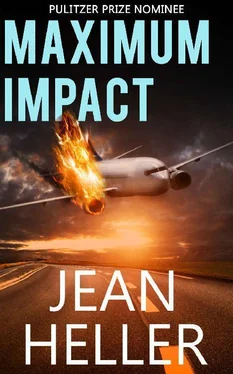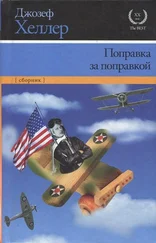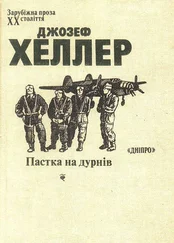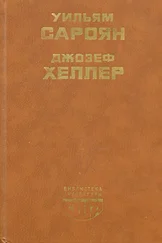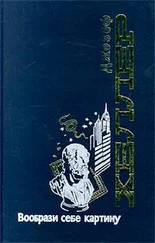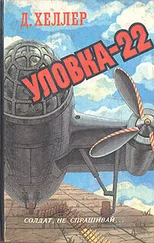It occurred to Kisparich that he could see the last actions of the frantic crew on the flight deck, and with that realization came another, so terrifying it seemed to shrink the skin of his abdomen and threaten to crush him in his own panic. What remained of the jetliner was skidding directly toward him, already so close he could feel the heat. It blotted out his view of the terminals, took out a cluster of landing lights on the side of the runway, and plowed a fiery furrow through the grass as it bore down on him.
He felt warm wetness on the insides of his thighs and under his legs that signaled the end of the need for a bathroom, and he jammed the throttle of his idling 172 in full, trying to get beyond the horror that loomed beside and over him.
Had he acted thirty seconds sooner, Howard Kisparich could have pulled it off. But the Cessna had just started inching forward when the nose of Flight 1117 rolled over and crushed it like a tin can. It pinned the Cessna and the remains of its pilot under two dozen tons of inferno and pushed the crumpled ruins off the taxiway and across Runway 30, until the entire mass came to rest in a grassy area still sodden from heavy spring rains.
If there were screams from within what remained of the jet, they could not be heard over the roar of the flames. If the fire trucks dispatched to the wreckage had been there already, neither man nor machinery could have closed in on the heat with any hope of saving even a single life. Under the warm sun of the most perfect spring day of the year, ConPac Flight 1117 and Cessna niner-seven-four-seven-Papa lay dead, burning and steaming like a nightmarish vision from hell.
Thursday, April 17th, 1:00 P.M.
The image would hang in Steve Pace’s memory like a new picture on a living-room wall, so obvious at first, drawing the eye every time the owner entered the room. Over time, it became less apparent, but it hung there, ready to return to sharp focus when attention was called to it, or when something happened to renew the memory of its acquisition.
So, against his will, Pace bought and paid in pain for the picture before him. It laid an imprint so deep he never forgot it, although months and years later it would become less a part of every day, less vivid, less sickening, but always there, horror waiting to be recalled.
The Sexton 811 stopped burning after firefighters spent two hours smothering it in foam. The roiling waves of smoke slid away on the cleansing breeze. Even from the vantage point where more than 200 reporters, photographers, and television technicians were isolated behind police barricades, Pace, the aviation reporter for the Washington Chronicle, was awed by what he saw.
Nothing of the 811 that remained undamaged. The tail assembly was barely recognizable. The vertical stabilizer was almost intact, although blackened and absent its rudder. The left horizontal stabilizer also was charred, the right horizontal stabilizer gone entirely, melted by the intensity of the fuel-fed flames. Blasted by the heat, the Converse engine on the left wing shriveled gnarly and black. It no longer resembled an engine so much as a misshapen, rotten tumor. The left wing jutted toward the sky at an unnatural angle, looking like the remnants of an arm reaching up for help that wasn’t there, an arm now frozen in death. The fuselage was torn or burned open in a dozen places Pace could see and in several more he couldn’t. It was blackened along its entire length. From where he stood, it looked as though the cockpit had ripped away from the rest of the aircraft and lay on its side like the battered head of a giant dead fish.
Through a pair of Nikon binoculars, Pace watched the frantic efforts to control the blaze, trading images with Chronicle photographer Tim Hogan, who was recording the scene with a tripod-mounted Nikon F4 and a gigantic 1,000-millimeter reflex lens. Hogan, a blond, slight, soft-spoken picture wizard, inevitably nicknamed “Hulk” by his associates, was shooting roll after roll of film, but from what Pace could see through his binoculars, good taste likely would prevent the use of much of the photographer’s material.
Through gaps in the aircraft’s skin, Pace could see dead passengers hanging upside down, still strapped into their seats in the left and center sections of the airplane, their arms thrown above their heads like teenagers rocking at a Springsteen concert. All were damaged graphically by the heat and flames, but they could be recognized at least as human beings; indeed, in some cases, there was enough left intact that next of kin would be able to make identification.
He could barely imagine what had happened to the passengers on the right side. Most of those seats were hidden under debris and behind jagged curtains of metal. Those were the passengers who had taken the brunt of the impact when the 811 flipped. For their families, visual identification would be impossible, and that probably was for the best.
Around the perimeter of the wreckage, Pace spotted a few burned and blackened mounds. He dismissed them as charred sacks of mail and baggage until rescue workers began covering them with plastic sheets.
But it was the ambulances that made the situation so final and so hopeless. There were eighteen when Pace reached the airport. More arrived, and eventually the fleet totaled twenty-nine. Two hours after the crash, one ambulance left with no sense urgency, its lights off, sirens silent. Now the rest began to drift away. It was the final word, if any were needed, that no amount of speed or urgency could help the passengers and crew of Consolidated Pacific Flight 1117, who started their day headed for Los Angeles but made fewer than three miles of the journey before they died.
Behind the barricades, the press corps was getting edgy. Airport police and officials of the National Transportation Safety Board had arranged for them to watch the firefighting efforts from about a quarter-mile away, close enough to see the action but far enough removed for safety. Now the fire was out, and there were increasing demands for permission to approach the wreckage.
Mitch Gabriel, the NTSB’s chief of public information, explained repeatedly that bits of the 811 were scattered over nine acres of airport grounds, and no one but the agency’s investigators were allowed within that area while the debris was inventoried and recovered. Everyone else had to be kept away to preserve the integrity of the evidence.
“Mitch, can you verify there were no survivors?” an Associated Press reporter yelled.
“We’ll have something on that later,” Gabriel said.
“Was it an experienced crew?” asked an NBC reporter.
“I don’t know the identities of the crew members, but any airline’s more experienced personnel generally get the jobs on the new-generation aircraft.”
“What’s the focus of the investigation right now?” Pace asked. “The right engine?”
“Steve, I have no comment now.”
Gabriel promised that an NTSB board member would hold a press conference later to brief more fully on the investigation, but there would be nothing more before the briefing. That was standard procedure, but the press corps would get what it wanted or spend the rest of the day grousing about it. That, too, was standard procedure.
Pace was used to it. He’d experienced the same media reaction on his first air-crash assignment and on every accident he’d covered since. How many of them had there been, actually? Four? Five? He was a young reporter for the San Diego Sun in September, 1978, when he covered his first, the in-flight collision over San Diego of a Boeing 727 and a Cessna 172 that killed 150 people. Although a rival paper won a Pulitzer Prize for its coverage of the disaster, Pace’s work was good enough to catch the attention of the editors of the Washington Chronicle, who offered him the open job of aviation writer.
Читать дальше
